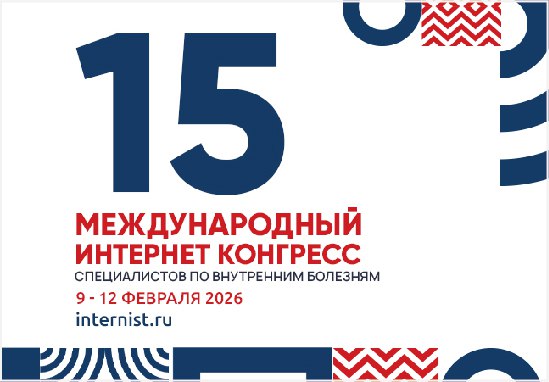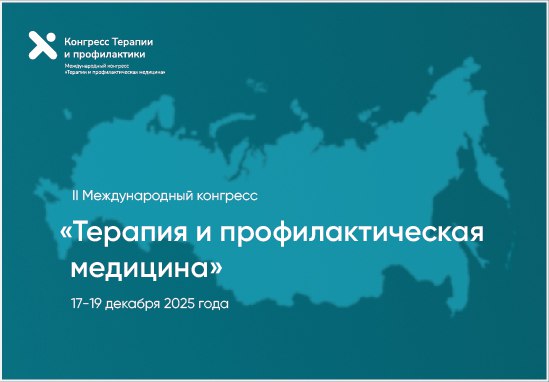Associations of body composition parameters with N-terminal pro-brain natriuretic peptide level in men with chronic heart failure
https://doi.org/10.20996/1819-6446-2025-3203
EDN: HZJBPG
Abstract
Aim. To study the associations of N-terminal pro-brain natriuretic peptide (NT-proBNP) level with body composition parameters in comparison with body mass index (BMI) in men with chronic heart failure (CHF).
Material and methods. The study included 60 men aged 20-70 years with CHF of various etiologies and reduced or mildly reduced left ventricular ejection fraction (LVEF). The BMI was calculated using the Quetelet formula: [BMI = body weight (kg)/height (m2)]. Quantitative body composition (fat, muscle, and bone mass) was determined using dual-energy X-ray absorptiometry. NT-proBNP level was determined with method of chemiluminescent enzyme immunoassay using MAGTRATION technology.
Results. NT-proBNP level in men with normal body weight was significantly higher than in overweight and obese individuals (680 [427; 2994], 446 [381; 1667], 300 [226; 967] pg/ml (p<0.05), respectively). The amount of both fat and muscle mass was significantly higher in obese individuals, however, in a linear regression analysis adjusted for age NT-proBNP levels were independently associated only with the appendicular muscle mass and the appendicular skeletal muscle index.
Conclusion. Patients with CHF and obesity have lower NT-proBNP values than those with normal body weight. An independent inverse association of NT-proBNP level with BMI and with indicators of muscle mass, but not body fat, was demonstrated. These findings suggest that the muscle component of body weight contributes to the lower NT-proBNP values in CHF patients with high BMI.
Keywords
About the Authors
E. K. YaralievaRussian Federation
Elvira K. Yaralieva
Moscow
I. A. Skripnikova
Russian Federation
Irina A. Skripnikova
Moscow
R. P. Myasnikov
Russian Federation
Roman P. Myasnikov
Moscow
O. V. Kulikova
Russian Federation
Olga V. Kulikova
Moscow
V. E. Novikov
Russian Federation
Valeri E. Novikov
Moscow
O. M. Drapkina
Russian Federation
Oksana M. Drapkina
Moscow
References
1. Fomin IV. Chronic heart failure in Russian Federation: what do we know and what to do. Russian Journal of Cardiology. 2016;(8):7-13. (In Russ.) DOI:10.15829/1560-4071-2016-8-7-13.
2. Russian Society of Cardiology. Chronic heart failure. Clinical guidelines 2020. Russ J Cardiol. 2020;25(11):4083. (In Russ.) DOI:10.15829/1560-4071-2020-4083.
3. Lundberg GD. Is there a relationship between waist circumference and mortality? Medscape J Med. 2008;10(8):202.
4. Kalantar-Zadeh K, Block G, Horwich T, Fonarow GC. Reverse epidemiology of conventional cardiovascular risk factors in patients with chronic heart failure. J Am Coll Cardiol. 2004;43(8):1439-44. DOI:10.1016/j.jacc.2003.11.039.
5. Shpagina OV, Bondarenko IZ. «Obesity Paradox» — another look at the problem of cardiovascular disease. Obesity and metabolism. 2013;10(4):3-9. (In Russ.) DOI:10.14341/omet201343-9.
6. Galyavich AS, Tereshchenko SN, Uskach TM, et al. 2024 Clinical practice guidelines for Chronic heart failure. Russian Journal of Cardiology. 2024;29(11):6162. (In Russ) DOI:10.15829/1560-4071-2024-6162.
7. McDonagh TA, Metra M, Adamo M, et al.; ESC Scientific Document Group. 2021 ESC Guidelines for the diagnosis and treatment of acute and chronic heart failure. Eur Heart J. 2021;42(36):3599-726. DOI:10.1093/eurheartj/ehab368. Erratum in: Eur Heart J. 2021;42(48):4901. DOI:10.1093/eurheartj/ehab670.
8. Heidenreich PA, Bozkurt B, Aguilar D, et al. 2022 AHA/ACC/HFSA Guideline for the Management of Heart Failure. J Am Coll Cardiol. 2022;79(17):e263-421. DOI:10.1016/j.jacc.2021.12.012. Erratum in: J Am Coll Cardiol. 2023;81(15):1551. DOI:10.1016/j.jacc.2023.03.002.
9. Vasyuk YuA, Shupenina EYu, Namazova GA, Dubrovskaya TI. Novel algorithms for diagnosing heart failure with preserved ejection fraction in patients with hypertension and obesity. Cardiovascular Therapy and Prevention. 2021;20(1):2569. (In Russ.) DOI:10.15829/1728-8800-2021-2569.
10. Madamanchi C, Alhosaini H, Sumida A, Runge MS. Obesity and natriuretic peptides, BNP and NT-proBNP: mechanisms and diagnostic implications for heart failure. Int J Cardiol. 2014;176(3):611-7. DOI:10.1016/j.ijcard.2014.08.007.
11. Lyasnikova EA, Kuular AA, Pavlovskaya AV, et al. Impact of obesity on echocardiographic parameters and N-terminal pro-brain natriuretic peptide levels in patients with heart failure with mid-range ejection fraction: unanswered questions. Russian Journal of Cardiology. 2021;26(6):4462. (In Russ.) DOI:10.15829/1560-4071-2021-4462.
12. Wang T, Larson M, Levy D, et al. Impact of obesity on plasma natriuretic peptide levels. Circulation. 2004;109(5):594-600. DOI:10.1161/01.CIR.0000112582.16683.EA.
13. Shalnova SA, Imaeva AE, Deev AD, et al. Elevated level of the natriuretic peptide among adult population in regions participating in the ESSE-RF study and its association with cardiovascular diseases and risk factors. Cardiology. 2017;57(12):43-52. (In Russ.) DOI:10.18087/cardio.2017.12.10065.
14. Das SR, Drazner MH, Dries DL, et al. Impact of Body Mass and Body Composition on Circulating Levels of Natriuretic Peptides: Results from the Dallas Heart Study. Circulation. 2005;112(14):2163-8. DOI:10.1161/CIRCULATIONAHA.105.555573.
15. Drapkina OM, Samorodskaya IV, Starinskaya MA, et al. Obesity: assessment and management tactics of patients. Collective monograph. Moscow: Federal State Budgetary Institution “NMRC TPM” of the Ministry of Health of the Russian Federation; OOO “Silitseya-Polygraf”. 2021. (In Russ.) ISBN: 978-5-9907556-0-4.
16. Skripnikova IA, Yaralieva EK, Myasnikov RP, et al. Body composition and functional activity in men with heart failure. Rational Pharmacotherapy in Cardiology. 2023;19(6):557-64. (In Russ.) DOI:10.20996/1819-6446-2023-2975.
17. Cruz-Jentoft AJ, Bahat G, Bauer J, et al.; Writing Group for the European Working Group on Sarcopenia in Older People 2 (EWGSOP2), and the Extended Group for EWGSOP2. Sarcopenia: revised European consensus on definition and diagnosis. Age Ageing. 2019;48(1):16-31. DOI:10.1093/ageing/afy169. Erratum in: Age Ageing. 2019;48(4):601. DOI:10.1093/ageing/afz046.
18. Kelly TL, Berger N, Richardson TL. DXA body composition: theory and practice. Appl Radiat Isot. 1998;49(5-6):511-3. DOI:10.1016/s0969-8043(97)00226-1.
19. Selvaraj S, Kim J, Ansari BA, et al. Body Composition, Natriuretic Peptides, and Adverse Outcomes in Heart Failure With Preserved and Reduced Ejection Fraction. JACC Cardiovasc Imaging. 2021;14(1):203-15. DOI:10.1016/j.jcmg.2020.07.022.
20. Oreopoulos A, Ezekowitz JA, McAlister FA, et al. Association between direct measures of body composition and prognostic factors in chronic heart failure. Mayo Clin Proc. 2010;85(7):609-17. DOI:10.4065/mcp.2010.0103.
21. Mueller C, McDonald K, de Boer RA, et al.; Heart Failure Association of the European Society of Cardiology. Heart Failure Association of the European Society of Cardiology practical guidance on the use of natriuretic peptide concentrations. Eur J Heart Fail. 2019;21(6):715-31. DOI:10.1002/ejhf.1494.
22. Chang AY, Abdullah SM, Jain T, et al. Associations among androgens, estrogens, and natriuretic peptides in young women: observations from the Dallas Heart Study. J Am Coll Cardiol. 2007;49(1):109-16. DOI:10.1016/j.jacc.2006.10.040.
23. Van Pelt RE, Gavin KM, Kohrt WM. Regulation of body composition and bioenergetics by estrogens. Endocrinol Metab Clin North Am. 2015;44(3):663-76. DOI:10.1016/j.ecl.2015.05.011.
Supplementary files
Review
For citations:
Yaralieva E.K., Skripnikova I.A., Myasnikov R.P., Kulikova O.V., Novikov V.E., Drapkina O.M. Associations of body composition parameters with N-terminal pro-brain natriuretic peptide level in men with chronic heart failure. Rational Pharmacotherapy in Cardiology. 2025;21(4):335-342. (In Russ.) https://doi.org/10.20996/1819-6446-2025-3203. EDN: HZJBPG
















































